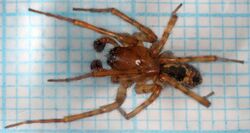Biology:Amaurobius fenestralis
| Amaurobius fenestralis | |
|---|---|

| |
| Male | |
| Scientific classification | |
| Domain: | Eukaryota |
| Kingdom: | Animalia |
| Phylum: | Arthropoda |
| Subphylum: | Chelicerata |
| Class: | Arachnida |
| Order: | Araneae |
| Infraorder: | Araneomorphae |
| Family: | Amaurobiidae |
| Genus: | Amaurobius |
| Species: | A. fenestralis
|
| Binomial name | |
| Amaurobius fenestralis (Ström, 1768)[1]
| |
Amaurobius fenestralis is a species of spider in the family Amaurobiidae.[1]
It is one of at least two common spiders found in houses known as lace-webbed spider, the other being Amaurobius similis. The specific name similis is based on its similarity to A. fenestralis. Both are often found near windows, hence the specific name of A. fenestralis. The two species are difficult to distinguish: A. fenestralis tends to be smaller and lighter in colouration when an adult. Both species have V-shaped markings on their abdomens, with A. fenestralis usually having two or three, and A. similis four. Examination of the genitalia may be needed for precise identification.[citation needed] This spider has been seen preying on another spider, Steatoda nobilis in areas around the UK.[2]
References
- ↑ 1.0 1.1 "Taxon details Amaurobius fenestralis (Ström, 1768)", World Spider Catalog (Natural History Museum Bern), http://www.wsc.nmbe.ch/species/1220, retrieved 2016-10-24
- ↑ Dugon, Michel M.; Dunbar, John P.; Afoullouss, Sam; Schulte, Janic; McEvoy, Amanda; English, Michael J.; Hogan, Ruth; Ennis, Collie et al. (2017). "Occurrence, reproductive rate and identification of the non-native Noble false widow spider Steatoda nobilis (Thorell, 1875) in Ireland". Biology and Environment: Proceedings of the Royal Irish Academy 117B (2): 77–89. doi:10.3318/bioe.2017.11. ISSN 0791-7945. https://www.jstor.org/stable/10.3318/bioe.2017.11.
External links
| Wikimedia Commons has media related to Amaurobius fenestralis. |
- Amaurobius fenestralis In: DrfpLib
Wikidata ☰ Q1762374 entry
 |

